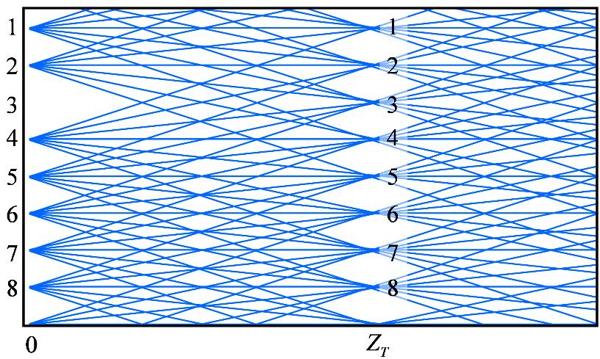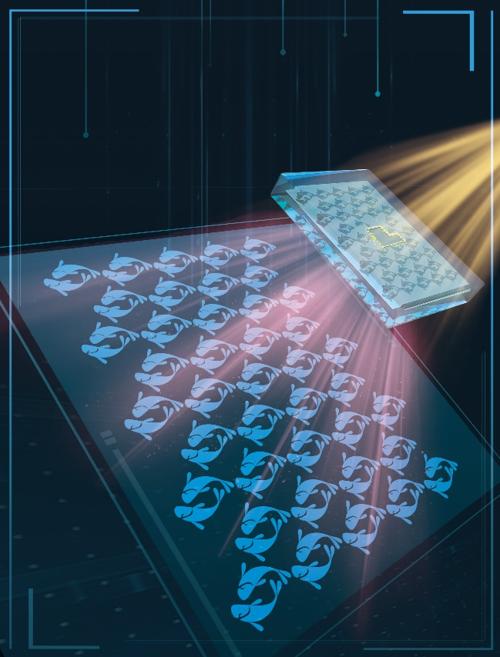Nonlinear Talbot effect is a near-field nonlinear diffraction phenomenon in which the self-imaging of periodic object is formed by the second harmonic of the incident laser beam. Different from its conventional linear analogue, the periodic object here is made with spatially modulated second-order nonlinear coefficient of the medium, and the spatial resolution in Talbot self-imaging is improved by a factor of 2 thanks to frequency doubling. Consequently, the nonlinear Talbot effect is superior in applications that require high resolution imaging and processing, such as nonlinear optical microscopy, lithography, spectrometry, and material characterization.The nonlinear Talbot effect was first observed in periodically poled LiTaO3 crystals, which are also known as nonlinear photonic crystals. The self-imaging of 1D periodically and 2D hexagonally poled ferroelectric domain structures was observed by using the second harmonic generated in the crystals. Following this pioneering work, the dependence of nonlinear Talbot distance on parameters of nonlinear photonic crystals and the fractional nonlinear Talbot effects were also investigated. Despite of these recent achievements, the fundamental properties and capabilities of nonlinear Talbot effect have not been thoroughly studied so far. For instance, very useful characteristic of Talbot effect is its capability to produce defect-free images from imperfect structures, property known as self-healing. While such capability of image restoration has been well studied in linear Talbot effect, it has never been investigated in the regime of nonlinear optics.

Illustrating Talbot self-healing, where the initially missing point (#3) is restored in the first Talbot image plane.
The research group led by Prof. Yan Sheng and Prof. Wieslaw Krolikowski from Ningbo University and Australian National University provided the first observation of nonlinear Talbot self-healing, i.e. the capability of creating defect-free images from faulty nonlinear optical structures. The research results are published in Chinese Optics Letters, Vol. 19, No. 6, 2021 (Bingxia Wang, et al., Nonlinear Talbot self-healing in periodically poled LiNbO3 crystal).
In this work the tightly focused femtosecond infrared optical pulses were used to fabricate LiNbO3 nonlinear photonic crystals by periodically inverting its spontaneous polarization. With the inversion of spontaneous polarization, the second-order nonlinear coefficient changes its sign. In this way the nonlinear periodic pattern was obtained in experiment. However, instead of producing a perfect periodic structure a few points were randomly removed from the 2D square and hexagonal lattices. The near-field nonlinear diffraction experiments show the missing elements are restored in the second harmonic images at the first nonlinear Talbot plane.
The observed nonlinear Talbot self-healing opens up new possibilities for defect-tolerant optical lithography and printing. As the photoelectronic industry continues to shrink the device size in integrated circuits, optical lithography will require higher resolution and accuracy. Any scratch or defects over a periodic mask will limits the resolution and accuracy of the lithographed feature. Fortunately, this problem can be overcome by nonlinear Talbot self-healing, which is a promising way to develop high resolution and defect-tolerant lithography by combining with extreme ultraviolet light source.
The nonlinear Talbot self-healing also offers a new way to realize information encryption. In fact, the capability of nonlinear Talbot self-healing depends critically on the severity of defects, i.e. high quality self-healing can only be obtained at a moderate level of structure's defects. Then by controlling the degree of these defects one may hide the information into the units that can self-heal via the nonlinear Talbot imaging. Similarly, the nonlinear Talbot effect works perfectly with periodic χ(2) structures, but is incapable of dealing with disordered patterns. Therefore, utilizing such different responses of periodic and disordered structures in the nonlinear Talbot self-imaging, similar effects of information encryption may be achieved too.
It has been widely accepted that the nonlinear Talbot self-imaging can be used as an efficient technique for diagnostic of the surface distributions of the second-order nonlinear coefficient of the nonlinear photonic crystals. This also offers a good way to analyze antiparallel ferroelectric domains in LiTaO3, LiNbO3, and many other ferroelectric crystals. However, according to the research results presented in this work, the nonlinear Talbot self-healing has to be accounted for in analysis of the nonlinear optical structures, as the minor defects or scratches cannot be detected.
The resolution of nonlinear Talbot imaging is defined by the diffraction limit at the second harmonic frequency in this work. In order to improve the resolution, one of the future research directions will be the extension of nonlinear Talbot self-imaging to the cascaded third harmonic generation. In this cascading nonlinear process, the incident fundamental wave is converted into the second harmonic at first, and then the generated second harmonic frequency mix with the rest fundamental beam to generate the third harmonic. In this way, the resolution of nonlinear Talbot self-imaging can be further improved by 1.5 times. Meanwhile, one may consider to study the nonlinear Talbot effects and associated new phenomena in other nonlinear optical parametric processes, such as the spontaneous parametric down conversion, which may inspire new applications in quantum optical technologies as an efficient way to generate entangled photon pairs.

Nonlinear Talbot self-healing: the capability of creating defect-free images from faulty nonlinear photonic structures by the second harmonic of the incident laser beam.


